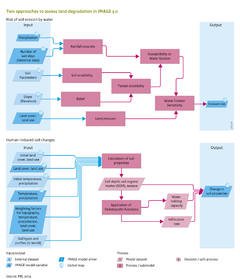Land degradation: Difference between revisions
Jump to navigation
Jump to search
Oostenrijr (talk | contribs) m (Reverted edits by Oostenrijr (talk) to last revision by RinekeOostenrijk) |
Oostenrijr (talk | contribs) m (Text replace - "km2" to "km<sup>2</sup>") |
||
| Line 12: | Line 12: | ||
In 2012, the UN Convention to Combat Desertification ({{abbrTemplate|UNCCD}}) formulated the goal to achieve zero net land degradation as a Sustainable Development Goal for [[Roads from Rio+20 (2012) project|Rio+20]] ''‘to secure the contribution of our planet’s land and soil to sustainable development, including food security and poverty eradication’'' ([[UNCCD, 2012]]). Land degradation is also relevant to the other Rio Conventions, with one of the Aichi targets of the Convention on Biological Diversity ({{abbrTemplate|CBD}}) aiming to restore at least 15% of degraded ecosystems. | In 2012, the UN Convention to Combat Desertification ({{abbrTemplate|UNCCD}}) formulated the goal to achieve zero net land degradation as a Sustainable Development Goal for [[Roads from Rio+20 (2012) project|Rio+20]] ''‘to secure the contribution of our planet’s land and soil to sustainable development, including food security and poverty eradication’'' ([[UNCCD, 2012]]). Land degradation is also relevant to the other Rio Conventions, with one of the Aichi targets of the Convention on Biological Diversity ({{abbrTemplate|CBD}}) aiming to restore at least 15% of degraded ecosystems. | ||
While recognized as a global threat, the impacts of land degradation are poorly understood, and studies report differing results. For instance, productive soil loss equals 15 million | While recognized as a global threat, the impacts of land degradation are poorly understood, and studies report differing results. For instance, productive soil loss equals 15 million km<sup>2</sup> according to [[Rozanov et al., 1990]], while FAO reports about 43 million km<sup>2</sup> moderately to severely degraded land because of soil quality loss, water resource depletion and biodiversity loss ([[FAO, 2011a]]). As a result, the impacts on productivity and economic losses with consequences for food security are also very uncertain. In the same way, the costs and benefits of investments to prevent land degradation and to restore degraded areas are also largely unknown ([[Nkonya et al., 2011]]). Many reasons for these discrepancies and knowledge gaps are identified ([[Bindraban et al., 2012]]), including uncertainty about data, ambiguous definitions of land degradation, and methodology weaknesses in attributing changes in ecosystems to land degradation or to other causes. | ||
Although a comprehensive model to capture the complex system interactions is not readily available, IMAGE 3.0 offers the following approaches to address soil degradation: | Although a comprehensive model to capture the complex system interactions is not readily available, IMAGE 3.0 offers the following approaches to address soil degradation: | ||
Revision as of 10:40, 1 July 2014
Parts of Land degradation
| Component is implemented in: |
|
| Related IMAGE components |
| Projects/Applications |
| Models/Databases |
| Key publications |
| References |
Key policy issues
- In what parts of the world have human-induced changes in land and soil conditions occurred?
- What are the future risks of soil degradation?
- To what extent are ecosystem functions lost by soil degradation, adding to local and global concerns about food security, biodiversity loss and climate change?
